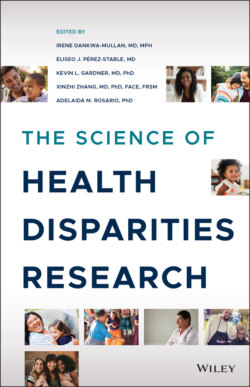Читать книгу The Science of Health Disparities Research - Группа авторов - Страница 38
2.5.2 Sleep Health Disparities and Genetics
ОглавлениеGenetics is clearly another important factor to consider. Genes account for 31–55% of a person's sleep duration, with behavior and environment accounting for the remainder [51]. Although genetics is a major contributor to sleep in all individuals, modifiable environmental factors are likely to play a larger role than genetics in poor sleep and poorer health between races. For instance, racial residential segregation resulting in differential exposure to artificial light at night, noise, and safety concerns due to poverty, for example, may have a more profound impact on sleep than genetic differences. Moreover, single nucleotide polymorphisms with minor allele frequencies (which generally need to be functional and may still confer small risks) are likely to play a much smaller role than the environment in shaping racial variation in health and disease. It is now widely accepted that race, as distinct from ancestry, is a social construct whose distinguishing phenotypes (e.g., skin and eye color) are not strongly linked to lifestyle‐related health conditions that cause the majority of premature deaths in the United States [52]. In fact, the human genome project found that all humans are 99.9% the same (meaning that genetic variants overlap). There is more genetic diversity within (especially among people of African ancestry) than between racial categories—which are, again, socially constructed and have changed over time.
Despite the large overlap of genetic variants across racial groups, studies should investigate how much (or how little) ancestral differences in genetic architecture (e.g., haplotypes, structural variation) contribute to observed differences in various sleep characteristics that affect health outcomes. These studies should also acknowledge that behaviors such as sleep are complicated and strongly influenced by nongenetic environmental factors. In fact, race could serve as a proxy/marker for relative advantage or disadvantage by identifying groups with more or less social and economic obstacles to health.
Finally, gene expression can be modified without altering an individual's actual genetic code (known as epigenetics, or gene‐by‐environment interactions). Environmental factors such as diet/nutrition, as well as toxicants (e.g., phthalates, flame retardants, surfactants, bisphenol‐A, and fungicides like vinclozolin), can promote the epigenetic transgenerational inheritance of disease and phenotypic variation [53]. Epigenetics (especially in early life) may play an important role in racial differences in the relationship between sleep and many health outcomes influenced by sleep, since Blacks and Whites have historically been and currently are exposed to different physical and social environments across the life course.
Behaviors and biological mechanisms along the pathway between sleep and suboptimal health outcomes are likely affected by the aforementioned upstream environmental and social factors, contributing to the often‐observed racial differences in risk, prevalence, and severity of both poor sleep characteristics and their downstream health sequelae.
